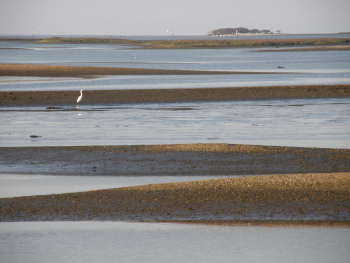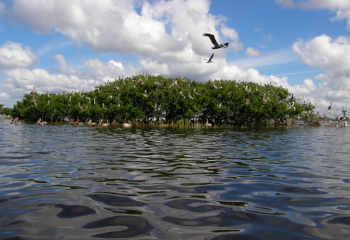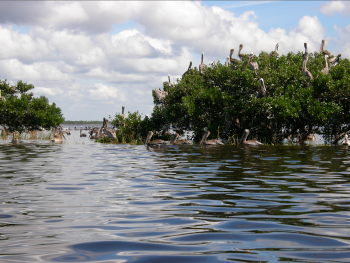Derrick Key Lament
 Derrick Key had been on the Gulf of Mexico's horizon, seen from the Shell Mound of the Lower
Suwannee NWR. Its silhouette to the southwest was as lovely a focal point as we could want.
Derrick Key had been on the Gulf of Mexico's horizon, seen from the Shell Mound of the Lower
Suwannee NWR. Its silhouette to the southwest was as lovely a focal point as we could want.
It's demise was foretold, but we hadn't anticipated the speed. Hurricane Hermine took it. The Derrick Key Channel, although it has moved itself, still flows through the constriction on the dozen mile route between the Suwannee River and the Cedar Keys. The channel markers remain.
Our next door neighbor, a thirty year old fourth generation oysterman, recently saw "the Derricks" exposed during a lower low tide, pushed out further by a cold front's northerlies. Old Derrick now is just more of the labyrinth of sand and oyster bars along this coast.
Since the end of the last major glaciation, about 14,000 years ago, sea level rose in the Gulf consistently for the first 7000 years. Then the rate of increase slowed by half for 5000 years until the industrial revolution. Now the rise is not just regional with local zig zags in the trend, it's all-at-once world wide, at rates multiples more than warming periods after the Pleistocene.
 Professor Ken Sassaman tested soot on "check-marked" pieces of pottery ("sherds") from Derrick.
The sherds were 1300 years old, from a time of low sea level, down as much as a foot and a half between
AD 200 and AD 650. Ken wrote, "Derrick shows us in real time how landforms get swallowed by tidal
water and reconfigured by tidal erosion."
Professor Ken Sassaman tested soot on "check-marked" pieces of pottery ("sherds") from Derrick.
The sherds were 1300 years old, from a time of low sea level, down as much as a foot and a half between
AD 200 and AD 650. Ken wrote, "Derrick shows us in real time how landforms get swallowed by tidal
water and reconfigured by tidal erosion."
From 1845, a dozen or so steamboats from 70 feet to 160 feet, 30 to 150 tons, drawing four feet or five, six at most, worked the Suwannee to the Gulf, and south to Cedar Key. The steamboats carried mail, freight, and passengers, stopping at McClamory Key for their boilers' water, three quarters of a mile east of Derrick.
In 1851 a Levy County coastal map labeled "Derricks Key." By 1854 it was named "Derrick Key," and, by 1861, the USGS chart showed islets within Derrick Key.
 March 1st, 1861, the first train of the first cross-Florida railroad came to Cedar Key from the Atlantic
Coast. Suwannee River traffic connected by steamboat to the railroad. April 12th the Civil War
began.
March 1st, 1861, the first train of the first cross-Florida railroad came to Cedar Key from the Atlantic
Coast. Suwannee River traffic connected by steamboat to the railroad. April 12th the Civil War
began.
Throughout the War, the North's boats blockaded Cedar Key, including the Suwannee. We can only imagine Derrick Key's role on the tidal channel squeezing traffic at the bottle-neck between the dark Suwannee and the salty Cedar Keys. Both sides intermittently used the railroad's tracks.
Lloyd Collins, 76, and Herman Wells, 79, are active Cedar Key watermen. They've dug quahog clams, netted mullet, trapped crabs, caught turtles, gathered oysters, farmed clams and guided sport fishermen inshore and offshore.
Talking in his wood shop, Herman gestured along its length, "We built the boats 24 feet, and my wife helped me turn the hulls over." He built one for Lloyd in Lloyd's yard.
 About 1950, each went to Derrick Key with their dads. The Key had mangroves and oaks - one of
which later had a tire swing - and at least two tall palms. Herman brought his young daughter
crabbing, and Lloyd stopped there when fishing with his kids.
About 1950, each went to Derrick Key with their dads. The Key had mangroves and oaks - one of
which later had a tire swing - and at least two tall palms. Herman brought his young daughter
crabbing, and Lloyd stopped there when fishing with his kids.
They remember and respect, still, a crabber, "Mister Bill" Hathcox. Herman said, "he had a small shack... to eat his lunch or get out of the rain. Those little conchs (Crown Conch Melongena corona) ate the bait in Mister Bill's traps and the crabs, too. He threw thousands ashore." Both recall, "The stink was terrible."
Lloyd jovially told of lima beans from a pot his mother had. In the 1950s, Mister Bill brought two men with a map out to Derrick Key, looking for a box. After their second visit a few days later, Mister Bill found the empty box and a big "bean pot."
In 2012, sailing canoe Bufflehead and I sailed around a couple clumps of dead mangroves, and through the gap in the Key's living ones. Karen and I sailed Bufflehead around it, too, and were beguiled by the Cormorants and Brown Pelicans roosting, jammed into the mangroves. The sandy bar that had stretched a couple hundred yards to the northeast often had scores of White and Brown Pelicans, hundreds of Black Skimmers, and more Gulf shorebirds than I could count or differentiate.
Since 2016, the view from the Shell Mound has had a void. That silhouette at sunset, bright green in the
morning, is gone. I remember an anguished line of movie dialog, "But, that was a priceless Steinway!"
Inspector Clouseau deadpanned back, "Not anymore."
It's another of life's 'it won't come back' facts. Derrick Key was washed away before Clam Girl was launched in 2018. We'll not forget Derrick when we sail over its vestigial bar.
~HH